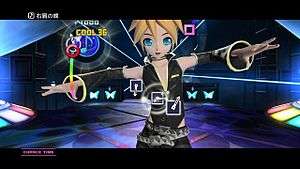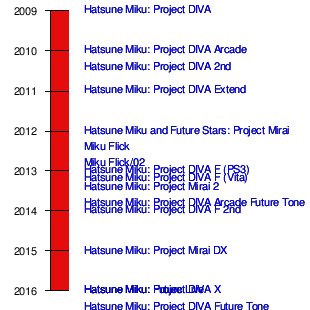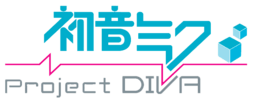Hatsune Miku: Project DIVA
| Hatsune Miku: Project DIVA | |
|---|---|
|
Official logo for the series | |
| Genres | Rhythm game |
| Developers |
Sega Crypton Future Media |
| Publishers |
Sega Dwango Music Entertainment |
| Platforms | PlayStation Portable, PlayStation 3, PlayStation 4, PlayStation Vita, Nintendo 3DS, Sega RingEdge, Sega Nu, iOS |
| Platform of origin | PlayStation Portable |
| First release |
Hatsune Miku: Project DIVA July 2, 2009 |
| Latest release |
Hatsune Miku: Project DIVA Future Tone June 23, 2016 |
Hatsune Miku: Project DIVA (初音ミク -Project DIVA-) is a series of rhythm games created by Sega and Crypton Future Media. The games have appeared on the PlayStation Portable, PlayStation 3, PlayStation 4, Nintendo 3DS, iOS, Sega RingEdge and PlayStation Vita platforms. The series currently consists of 5 main titles and 3 spin-offs. The series primarily makes use of Vocaloids, a series of singing synthesizer software, and the songs created using these Vocaloids most notably the virtual-diva Vocaloid Hatsune Miku. The game is the first video game to utilize the Vocaloid software developed by the Yamaha Corporation.
Gameplay
As the game is a rhythm game, players are allowed to choose from a wide variety of Vocaloid songs, original songs sung by Vocaloids, including songs sung by Hatsune Miku, Kagamine Rin and Len. Players also can choose which character they wish to play in the game. Known as modules, these modules can be completely different characters or simply different costumes for the same characters. These modules, though not directly controlled by the player, will be the ones appearing in the music videos throughout the game including their specific costumes. For example, if the player chooses Kagamine Rin for their first character and Hatsune Miku for their second character, during solo songs only Kagamine Rin appears in the video but for duets both Hatsune Miku and Kagamine Rin will appear in the video. Each of the songs have their own difficulties which are Easy, Normal, Hard and Extreme. Initially both the Easy and Normal difficulties of a song are unlocked, upon clearing the Normal difficulty, the Hard difficulty will be unlocked and so forth. Players progress through the game by completing songs and unlocking more new songs until they eventually unlock all songs.[1][2][3]

Note the Circle and Square symbols floating as well as the "Cool" rating of the hit.
The game's gameplay is similar to that of other rhythm games in which players must press a series of buttons according to the sequence on the screen. The game primarily makes use of the 4 main symbols, X, circle, square and triangle, which are the face buttons for the PlayStation Portable. Various floating gray buttons of those symbols will appear on the screen, and the colored version of those symbols will begin to float in from the various sides of the screen. The player is required to press the face button once the colored symbol lands on its grayed version and based on the player's timing their accuracy is rated. Accuracy is described with a word displayed in the bottom right corner of the screen, ranging from "cool" to "worst". The game is scored on accuracy and the player is awarded with a rank ranging from "Perfect" to "Mistake" (denoted by MissXTake). It also includes a chance mode whereby the combo system compounds points earned, for example one perfect note gives you 100 points, if you have a combo of 34 notes, the 34th note alone gives you an additional 3400 points.[1][3][4]
In addition to the game's standard rhythm game feature, is the ability for user-generated content in the game's Edit Mode. The Edit Mode allows users to create their own custom Promotional Video (PV) or Music Video, which either uses songs already in the game or any MP3 format music file from the player for the PV. Players can customize the video playing in the background, the various modules, backgrounds, costumes and even dance moves by the modules in the PV. Players can also modify the module's face to make the module appear to be singing so as to lip-sync the custom song to the video. Other than the Edit Mode, there is also a Diva's Room mode in which players can buy and obtain items throughout the game or from the in-game store to decorate their module's room with. Players can also take screenshots of their modules whilst they are playing in their room.[1][2][4]
Games

Project Diva
- Hatsune Miku: Project DIVA
- Hatsune Miku: Project DIVA is the first game in the Project Diva series, first released on July 2, 2009 for the PlayStation Portable handheld. The game was later playable on the PlayStation 3 using software known as Dreamy Theater, which allowed connectivity between the PSP and the PS3.
- Hatsune Miku: Project DIVA Arcade
- Hatsune Miku: Project DIVA Arcade is an arcade game in the Project Diva series, and featured many new exclusive features. Though it was a port of the original Project Diva game, the Arcade version featured many new songs that were from the unreleased Project Diva 2nd along with updated High Definition visuals akin to the Dreamy Theater version of the first game. A sequel titled Project DIVA Arcade Future Tone was announced on May 22, 2013, and later released on November 21, 2013. The game will also be ported to the PlayStation 4 in 2016 under the name Hatsune Miku: Project DIVA Future Tone.[5]
- Hatsune Miku: Project DIVA 2nd
- Hatsune Miku: Project DIVA 2nd is the sequel to Project Diva and was released on July 29, 2010 for the PlayStation Portable handheld, almost exactly a year after the first game. Similar to the first game, Dreamy Theater 2nd was also released, allowing players to play the game on the PlayStation 3 with High Definition visuals. This second instalment of Dreamy Theater introduced stereoscopic 3D for the first time in the series. The game also brought about a few new features though most of the gameplay widely remained the same, the new features included a new difficulty, duet songs and DIVA Room.
- Hatsune Miku: Project DIVA Extend
- Hatsune Miku: Project DIVA Extend is an expansion to Project Diva 2nd for the PlayStation Portable with the interface, graphics and gameplay being virtually the same as Project Diva 2nd. It was released on November 10, 2011 and featured a wide variety of new models and new songs. The game allowed players to import data from Project Diva 2nd into the game, including saves, songs, costumes and Downloadable Content. Similar to past games in the series, a companion game Hatsune Miku: Project DIVA Dreamy Theater Extend was released on the PlayStation 3 on September 13, 2012 with improved visuals and support for stereoscopic 3D.[6][7]
- Hatsune Miku: Project DIVA F
- Hatsune Miku: Project DIVA F or f is the next main entry in the Project Diva series that makes its debut on the PlayStation Vita and on the PlayStation 3 as a full-fledged game rather than downloadable software like Dreamy Theater. It was released on August 30, 2012 for the PlayStation Vita and on March 7, 2013 for the PlayStation 3. Though both are essentially the same game, the PS3 version includes additional songs and costumes. The songs will later be released as downloadable content for the PlayStation Vita.[8] The PlayStation Vita will also have additional gameplay features such as "scratch" that make use of its touch-screen and touch-panel features and AR features using the front and back camera.
- On March 7, 2013, Sega posted an image of Project DIVA F on their Facebook page, asking fans to like and share if they want to see the game released in Western territories.[9] The game was released in US on 27 August and 3 September in Europe.
- Hatsune Miku: Project DIVA F 2nd
- Hatsune Miku: Project DIVA F 2nd is the direct sequel to Project DIVA F, and was also available on PlayStation Vita and PlayStation 3. It was released on March 27, 2014.[10]
- Hatsune Miku: Project DIVA X
- Hatsune Miku: Project DIVA X was announced on the eighth anniversary of Hatsune Miku (August 31, 2015). It was released in Japan on March 24th, 2016 for the PlayStation Vita and on August 25th, 2016 for the PlayStation 4. Project Diva X was released on August 30th, 2016 in the US/UK for the PlayStation 4 and PlayStation Vita.
- Hatsune Miku: Future Tone
- Hatsune Miku Future Tone is a PS4 port of the arcade games of the same name. The port of the games will be released as two parts. The first part, named Future Sound, will focus on songs from the main Project Diva series. While the second game, named Colorful Tone, will focus on songs from the Project Mirai and arcade series. Both ports aren't stand-alone titles and players will be able to use earned modules in both games. The game in set for a PlayStation Store release in Japan on June 23 2016, and the game will cost 3900 yen for each part.[11]
- Hatsune Miku: Project Future Tone
- Hatsune Miku: Future Live is the first game which is free and can be played on Playstation VR.
Project Mirai Series
- Hatsune Miku and Future Stars: Project Mirai
- Hatsune Miku and Future Stars: Project Mirai is a spin-off from the series, with a different art-style and gameplay from the series. It is also the first game in the series not to be released on the Sony consoles of gaming products, instead being released on the Nintendo 3DS. The game was released on March 8, 2012, and it added several new features to the series. The game had Augmented Reality features using cards to show 3D models on the 3DS Cameras, as well as the voice and lyrics in a song to change according to the selected Vocaloid. The game also used the Nendoroid art style.
- Hatsune Miku: Project Mirai 2
- Hatsune Miku: Project Mirai 2 is a direct sequel to Hatsune Miku and Future Stars: Project Mirai and the second game to be released for the Nintendo 3DS. It was released on November 28, 2013. The game makes use of the touch screen, circle pad, and directional pad. It also makes use of Internet Co., Ltd. Vocaloid, Megpoid Gumi and has a mini-game based on the Puyo Puyo series.
- Hatsune Miku: Project Mirai DX
- Hatsune Miku: Project Mirai DX is an upgraded version of Hatsune Miku: Project Mirai 2. Although it didn't add much- only adding one new song, new videos, a new chart, and a new higher difficulty option- it was the first Project Mirai game to be released outside of Japan on the Nintendo 3DS. The game was released on May 28, 2015 in Japan, September 8, 2015 in the US, and on September 11, 2015 in Europe.
Spin-offs
- Miku Flick
- Miku Flick is a spin-off from the series, with a different gameplay from the series though featuring the same art style and PVs. The game was released on iOS in Japan on March 9, 2012 and internationally on April 9, 2012 making it the first game in the series to ever be localized into English. The game features a different gameplay whereby the player "flicks" the lyrics of the song in certain directions. The lyrics are placed on 10 separate tiles and players have to flick those tiles in the given direction.
- Miku Flick/02
- Miku Flick 02 is a spin-off in the Project Diva series and a sequel to Miku Flick. The game is the second to be released on the iOS platform and the second game to be released in English. In addition, the game features Kagamine Rin, Kagamine Len and Megurine Luka as playable characters whilst the first game only featured Hatsune Miku. The game also adds other gameplay options, and support for new songs and new costumes as downloadable content.
Characters

(From Left to Right) KAITO, MEIKO, Kagamine Len, Hatsune Miku, Kagamine Rin, Megurine Luka (Project DIVA F graphics.)
The current list of characters who have appeared in the series are:
| Character | Game | |||||||||||
|---|---|---|---|---|---|---|---|---|---|---|---|---|
| Project DIVA | Project DIVA Arcade | Project DIVA 2nd | Project DIVA Extend | Project Mirai | Miku Flick | Miku Flick/02 | Project DIVA F | Project Mirai 2 | Project DIVA Arcade Future Tone | Project DIVA F 2nd | Project DIVA X | |
| Hatsune Miku | Playable | |||||||||||
| Kagamine Rin | Playable | Playable | ||||||||||
| Kagamine Len | Playable | Playable | ||||||||||
| KAITO | Playable | DLC | Playable | |||||||||
| Megurine Luka | Playable | Playable | ||||||||||
| MEIKO | Playable | DLC | Playable | |||||||||
| Sakine Meiko | Playable | Unlockable | Playable | Unlockable | DLC | |||||||
| Akita Neru | Playable | DLC | Playable | DLC | ||||||||
| Yowane Haku | Playable | DLC | Playable | DLC | ||||||||
| Kasane Teto | DLC | DLC | Playable | DLC | ||||||||
| Mikudayo | DLC | |||||||||||
| GUMI | Playable | Playable | ||||||||||
Sales
The series has been popular among fans in Japan, having sold over 1 million copies as of April 2012 in Japan alone.[12] In July 2014, Sega announced that the franchise has sold a total of 2.5 million games within Japan.[13][14] As of November 2014 the franchise has sold 4.5 million units at retail and downloads.[15]
References
- 1 2 3 Spencer (September 3, 2008). "Sega's Hatsune Miku game appears to be easy to play". Siliconera. Retrieved April 12, 2012.
- 1 2 Jenni (August 16, 2009). "Show Off Your Hatsune Miku: Project Diva Screenshots". Siliconera. Retrieved April 12, 2012.
- 1 2 Spencer (April 23, 2009). "Have Another Look At Hatsune Miku: Project Diva". Siliconera. Retrieved April 12, 2012.
- 1 2 Jenni (August 18, 2009). "The Magic of Hatsune Miku: Project Diva". Siliconera. Retrieved April 12, 2012.
- ↑ http://gematsu.com/2015/09/hatsune-miku-project-diva-future-tone-announced-ps4
- ↑ Anoop Gantayat (May 30, 2012). "New PS3 Hatsune Miku Dreamy Theater Announced". Andriasang. Retrieved May 30, 2012.
- ↑ Anoop Gantayat (May 31, 2012). "First Look: Hatsune Miku Project Diva Dreamy Theater Extend". Andriasang. Retrieved May 30, 2012.
- ↑ Ishaan (2012-11-21). "Hatsune Miku: Project Diva F Will Return On PlayStation 3 In March". Siliconera.com. Retrieved 2013-10-13.
- ↑ "Sega Asks for Fan Support for Hatsune Miku: Project Diva F in the West". Anime News Network. Retrieved 2013-10-13.
- ↑ 2014-03-01, Luster, Joseph (March 1, 2014). "VIDEO: "Hatsune Miku: Project Diva F 2nd" Has Another Massive Digest Trailer". Crunchyroll. Retrieved October 2, 2015.
- ↑ "Hatsune Miku: Project Diva Future Tone details Future Sound and Colorful Tone versions". Gematsu. Retrieved 2016-04-12.
- ↑ Anime News Network Staff (April 12, 2012). "Hatsune Miku -Project Diva- Series Reaches 1 Million Units Shipped". Anime News Network. Retrieved April 13, 2012.
- ↑ Romano, Sal (July 1, 2014). "Hatsune Miku series sales reach 2.5 million in Japan". Gematsu. Retrieved October 2, 2015.
- ↑ "Sega Shipped Over 2.5 Million Hatsune Miku Games In Japan". Siliconera. July 2, 2014. Retrieved October 2, 2015.
- ↑ "Annual Report 2014 - SEGA SAMMY HOLDINGS" (PDF). SEGA SAMMY. Retrieved October 2, 2015.
External links
- Official Hatsune Miku: Project DIVA website (Japanese)
